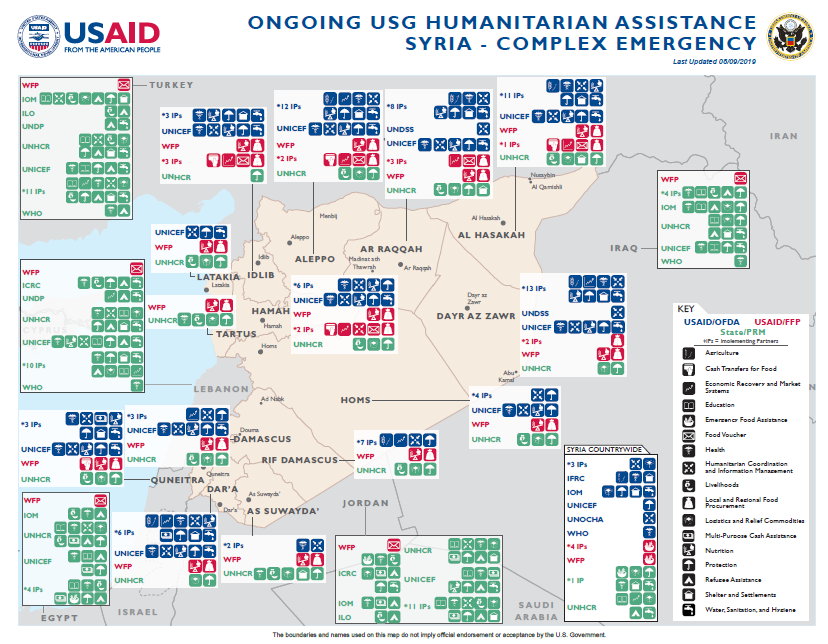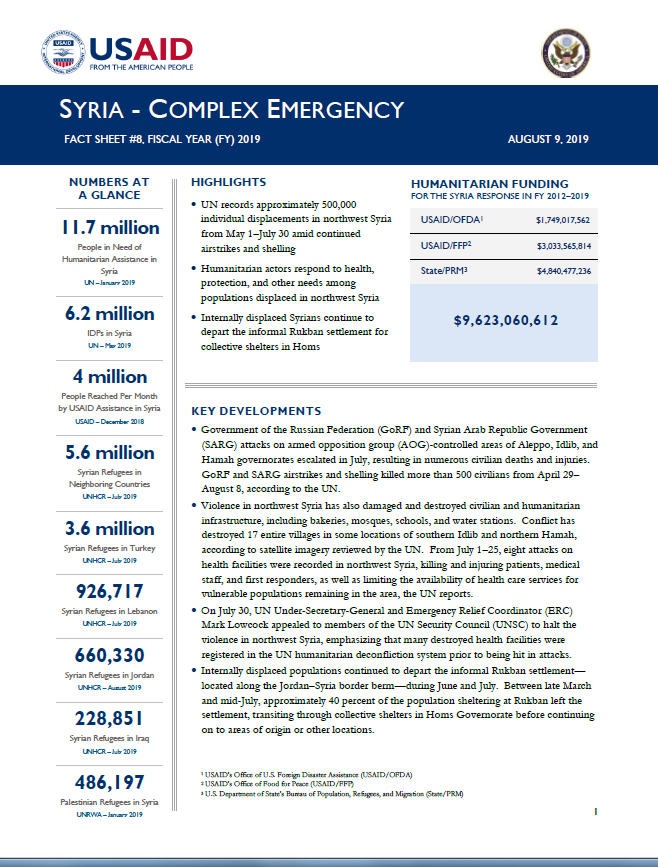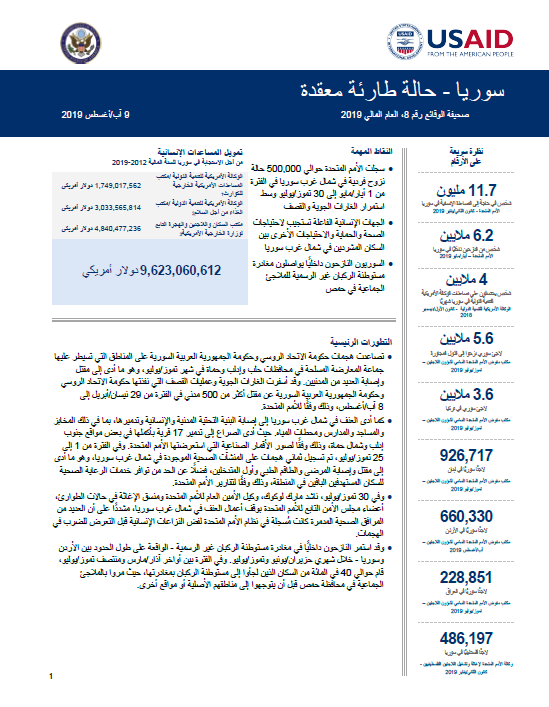- What We Do
- Agriculture and Food Security
- Democracy, Human Rights and Governance
- Economic Growth and Trade
- Education
- Environment and Global Climate Change
- Gender Equality and Women's Empowerment
- Global Health
- Humanitarian Assistance
- Transformation at USAID
- Water and Sanitation
- Working in Crises and Conflict
- U.S. Global Development Lab
Speeches Shim
August 09, 2019
Highlights
UN records approximately 500,000 individual displacements in northwest Syria from May 1–July 30 amid continued airstrikes and shelling
Humanitarian actors respond to health, protection, and other needs among populations displaced in northwest Syria
Internally displaced Syrians continue to depart the informal Rukban settlement for collective shelters in Homs
Key Developments
Government of the Russian Federation (GoRF) and Syrian Arab Republic Government (SARG) attacks on armed opposition group (AOG)-controlled areas of Aleppo, Idlib, and Hamah governorates escalated in July, resulting in numerous civilian deaths and injuries. GoRF and SARG airstrikes and shelling killed more than 500 civilians from April 29–August 8, according to the UN.
Violence in northwest Syria has also damaged and destroyed civilian and humanitarian infrastructure, including bakeries, mosques, schools, and water stations. Conflict has destroyed 17 entire villages in some locations of southern Idlib and northern Hamah, according to satellite imagery reviewed by the UN. From July 1–25, eight attacks on health facilities were recorded in northwest Syria, killing and injuring patients, medical staff, and first responders, as well as limiting the availability of health care services for vulnerable populations remaining in the area, the UN reports.
On July 30, UN Under-Secretary-General and Emergency Relief Coordinator (ERC) Mark Lowcock appealed to members of the UN Security Council (UNSC) to halt the violence in northwest Syria, emphasizing that many destroyed health facilities were registered in the UN humanitarian deconfliction system prior to being hit in attacks.
Internally displaced populations continued to depart the informal Rukban settlement—located along the Jordan–Syria border berm—during June and July. Between late March and mid-July, approximately 40 percent of the population sheltering at Rukban left the settlement, transiting through collective shelters in Homs Governorate before continuing on to areas of origin or other locations.
Syria Complex Emergency - Map #8 FY 2019 ![]() (pdf - 487k)
(pdf - 487k)
Numbers At A Glance
11.7 million
6.2 million
4 million
5.6 million
3.6 million
926,717
660,330
228,851
486,197
Humanitarian Funding
To Syria Humanitarian Response
FY 2012 - FY 2018
| USAID/OFDA | $1,749,017,562 |
| USAID/FFP | $3,033,565,814 |
| State/PRM | $4,840,477,236 |
| TOTAL | $9,623,060,612 |
Syria Complex Emergency - Fact Sheet #8 FY 2019 ![]() (pdf - 386k)
(pdf - 386k)
سوریا - حالة طارئة معقدة ![]() (pdf - 717k)
(pdf - 717k)
INSECURITY, DISPLACEMENT
Northwestern Syria
During July, GoRF and SARG airstrikes and shelling in western Aleppo, northern Hamah, and southern Idlib continued, resulting in civilian deaths and damage to civilian and humanitarian infrastructure. Between April 29 and August 8, the Office of the UN High Commissioner for Human Rights documented more than 500 deaths in northwest Syria as a result of the offensive.
Conflict resulted in approximately 500,000 displacements from and within Aleppo, Hamah, and Idlib between May 1 and July 30, with many of the displaced individuals moving multiple times during the period, the UN reports. The majority of internally displaced persons (IDPs) continue to flee toward and shelter in Idlib’s Dana sub-district, resulting in overcrowding of IDP camps and informal settlements and overstretching of humanitarian assistance capacities in the area. Of the estimated 3 million people in northwest Syria, approximately 1.3 million are IDPs, according to the UN.
Humanitarian actors continue to express severe concern regarding the damage and destruction of civilian infrastructure in northwest Syria resulting from GoRF and SARG attacks. Many civilian locations had been registered in the UN humanitarian deconfliction system prior to being hit by airstrikes; the process of deconfliction includes an exchange of information and planning between relief actors and parties to a conflict to protect civilians and humanitarian personnel.
In separate late July statements, UN High Commissioner for Human Rights Michelle Bachelet and ERC Lowcock called for the cessation of hostilities in the region, emphasizing concerns regarding attacks on deconflicted sites and the rising number of civilian casualties. On August 1, UN Secretary-General (SYG) António Guterres established an internal UN Headquarters Board of Inquiry to investigate a series of incidents—including destruction of, or damage to, facilities on the deconfliction list and UN-supported facilities—that have occurred in northwest Syria since the GoRF and the Government of Turkey signed an agreement to stabilize the Idlib area in September 2018.
Northeastern Syria
Approximately 68,800 people—of whom 94 percent are women and children—were sheltering in Al Hasakah Governorate’s Al Hol camp as of July 31, the UN reports. The camp population figure decreased slightly during June and July, due to the repatriation of some third-country nationals, the departure of hundreds of Syrians from Al Hol to areas of Dayr az Zawr and Ar Raqqah governorates, and the deregistration of individuals who were not present for three consecutive rounds of humanitarian assistance distributions. Although humanitarian needs among the population at Al Hol remain high, relief organizations continue to scale up activities, including health care and water and sanitation services, according to the UN.
Southern Syria
Syrians continued to depart the informal Rukban settlement through early July. More than 16,600 individuals, including nearly 7,500 children ages 18 years and younger, left the settlement for collective shelters in Homs from March 24 to July 10, the UN reports. An estimated 41,700 people had been sheltering at Rukban as of late March. Approximately 460 people remained at the Homs collective shelters as of July 13, with the remainder having departed to settle in areas of origin or other locations. With support from the UN, the Syrian Arab Red Crescent continues to provide health care, food assistance, and relief commodities to people as they transit through the Homs shelters and upon arrival at destination areas.
PROTECTION
In June, relief agencies—including U.S. Government (USG) partners—provided emergency response services to nearly 44,100 recently displaced people in 31 sub-districts of Aleppo and Idlib, according to the Protection Cluster—the coordinating body for humanitarian protection activities, comprising UN agencies, non-governmental organizations (NGOs), and other stakeholders. In addition, humanitarian actors provided a range of protection services to vulnerable populations in Aleppo, Idlib, and Ar Raqqah, reaching nearly 220,100 people with community-based protection services and more than 31,800 people with legal counseling or assistance. Relief actors also provided child protection programs, including psychosocial support (PSS) interventions, to more than 123,700 children in Syria during June and reached more than 3,000 children with case management services, the Protection Cluster reports.
State/PRM partner the Office of the UN High Commissioner for Refugees (UNHCR) continues to support Syrian refugees in Jordan requiring assistance with registration, resettlement, and other services through the Refugee Helpline. Staff monitoring the helpline answered more than 310,000 calls during May, providing legal advice and consultations, as well as transferring emergency and protection-related cases to on-call UNHCR staff with specialized skills. The hotline utilizes interactive technology—including pre-recorded and tailored messages to answer more than 500 common questions—to improve the helpline’s efficiency. Of several similar UNHCR-established hotlines established across the world, Jordan’s is one of the busiest, responding to more than 3 million calls since it was created in 2008.
HEALTH
USAID/OFDA partner the UN World Health Organization (WHO) continues to respond to the health care needs of displaced populations in northwest Syria, where ongoing conflict has damaged health care infrastructure and severely limited the availability of health care services. WHO supports seven mobile teams and two primary health care facilities in Idlib to provide critical medical services to IDPs. In addition, the UN agency supports five surgical units and five ambulances and provides mental health support to newly displaced individuals through four mental health care-focused mobile teams. During June, WHO also continued to deliver medicines and medical equipment to approximately 100 health facilities in northwest Syria; supplies provided during the month supported more than 798,500 individual medical treatments.
SHELTER AND RELIEF COMMODITIES
Humanitarian actors—including USG partners—provided clothing, household items, hygiene supplies, and water containers to nearly 354,000 vulnerable individuals in Syria during May and June, according to the Non-Food Item (NFI) Sector. From January–June, organizations coordinating through the NFI Sector—led by State/PRM partner UNHCR—supported more than 2.6 million people with relief items.
In May, with State/PRM support, UNHCR provided 7,000 sets of relief commodities and 120 tents to more than 35,700 people newly displaced by conflict in Aleppo and Idlib. The UN agency also provided nearly 11,200 familysized tents to 56,000 IDPs in northern Idlib from May 1–June 13 and provided blankets and mattresses to the governorate’s Maret Al Ekhwan IDP reception center.
FOOD SECURITY AND NUTRITION
From July 1–26, food security actors in northwest Syria, including USAID/FFP partner the UN World Food Program (WFP), reached nearly 52,800 people with emergency food baskets, more than 3,780 people with emergency multipurpose cash assistance, and more than 22,000 people with ready-to-eat rations (RTEs)—portable food rations designed to meet the food needs of a recently displaced family of five for five days, the UN reports. Since May 1, WFP has provided RTEs to approximately 256,000 Syrians displaced by conflict in northwest Syria. Food security actors prepositioned nearly 131,000 RTEs in Syria and Turkey, sufficient to meet the short-term food needs of approximately 655,000 people.
From July 25–28, hostilities temporarily prevented WFP from delivering assistance to 13,400 people in southern Idlib. As of August 6, WFP distributions remain suspended in northern Hamah due to insecurity, affecting approximately 7,000 food-insecure Syrians.
During the week of July 1, WFP began monthly distributions of electronic food vouchers and cash transfers for food to approximately 12,500 vulnerable non-Syrian refugees—primarily Iraqis—sheltering in Jordan, after the Government of the Hashemite Kingdom of Jordan (GoHKJ) granted WFP permission on June 23 to distribute the emergency food assistance. Jordan remains one of the countries affected highly by the Syrian crisis and hosts the second highest share of refugees per capita in the world—a total of nearly 753,400 refugees from Iraq, Sudan, Syria, Yemen, and other countries, of whom more than 660,000 are Syrian refugees, UNHCR reports.
Between July 1 and 26, community health workers screened nearly 6,280 recently displaced children younger than five years of age and more than 1,700 pregnant and lactating women for acute malnutrition in Aleppo and Idlib. The workers identified approximately 60 children experiencing severe acute malnutrition (SAM) and nearly 500 children experiencing moderate acute malnutrition (MAM); all children and women experiencing SAM and MAM were referred to health facilities to receive treatment, the UN reports. In addition, community health workers distributed nutrition supplies to an estimated 5,800 children and pregnant and lactating women during the period.
EDUCATION AND LIVELIHOODS
With State/PRM support, the UN Children’s Fund (UNICEF) supports education for both Syrian refugees and vulnerable host community populations in Egypt, Iraq, Jordan, Lebanon, and Turkey in an effort to encourage greater social cohesion. From January to June, the UN agency reached approximately 922,000 children with formal education and 30,000 children with non-formal education opportunities in the five countries.
As of June, approximately 76,900 Syrian refugees were sheltering in Za’atari camp, located in Jordan’s Mafraq Governorate, where livelihoods opportunities are limited. To support Syrians in meeting household needs, State/PRM partner UNHCR facilitates an incentive-based volunteering (IBV) program in Za’atari, through which refugees can earn income by assisting humanitarian organizations to provide camp services. In June, nearly 5,100 refugees participated in the IBV program.
In addition to IBV, the UN agency supports vocational skills training at Za’atari and works with the GoHKJ and State/PRM partner the International Labor Organization (ILO) to assist Syrian refugees in accessing employment opportunities and acquiring work permits. UNHCR also supports Syrian refugees in Jordan—including populations sheltering in formal camps and with host communities—with multipurpose cash assistance, reaching nearly 121,300 individuals during June.
State/PRM partner UNHCR continues to assist Syrian refugees in Jordan to obtain work permits, connect to employment opportunities outside refugee camps, and participate in livelihoods programs with a cash assistance component. From early 2016 to late June 2019, approximately 146,200 Syrian refugees—comprising 139,500 men and 6,700 women—acquired work permits from the GoHKJ. Of the total, approximately 18,400 Syrians sheltering in Jordan’s Azraq and Za’atari refugee camps received support from UNHCR and ILO to obtain work permits.
PUBLIC DONATION INFORMATION
The most effective way people can assist relief efforts is by making cash contributions to humanitarian organizations that are conducting relief operations. A list of humanitarian organizations that are accepting cash donations for disaster responses around the world can be found at www.usaid.gov/crisis/syria.
The USG encourages cash donations because they allow aid professionals to procure the exact items needed (often in the affected region); reduce the burden on scarce resources (such as transportation routes, staff time, and warehouse space); can be transferred very quickly and without transportation costs; support the economy of the disaster-stricken region; and ensure culturally, dietary, and environmentally appropriate assistance.




Comment
Make a general inquiry or suggest an improvement.